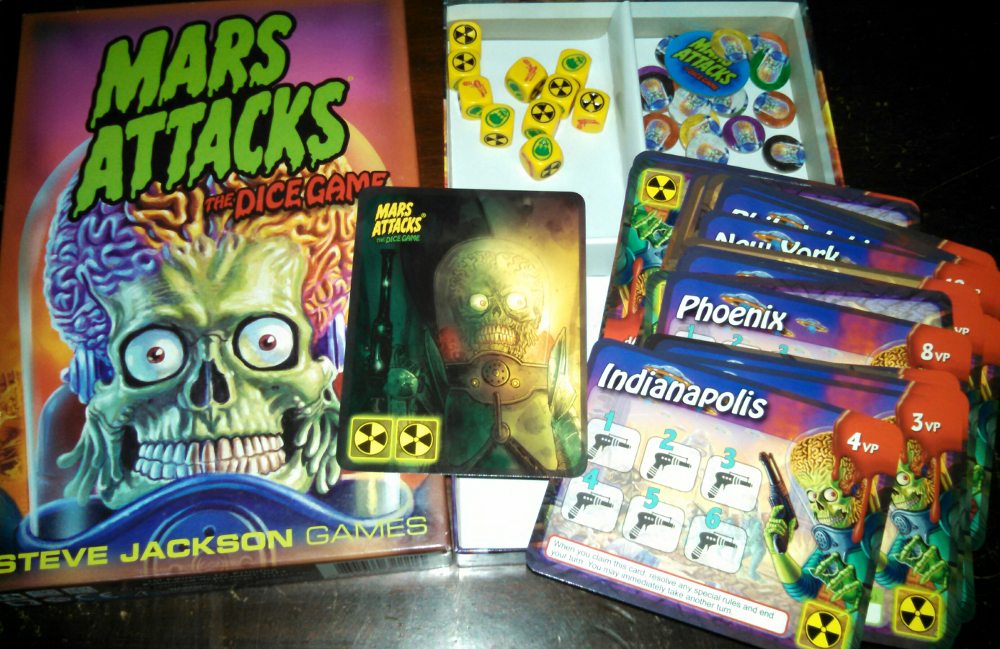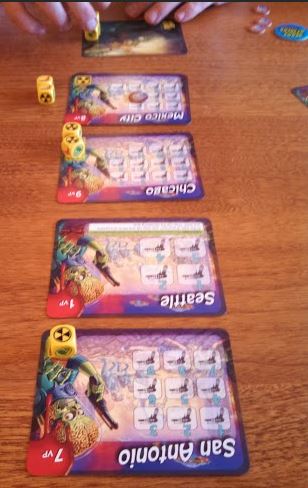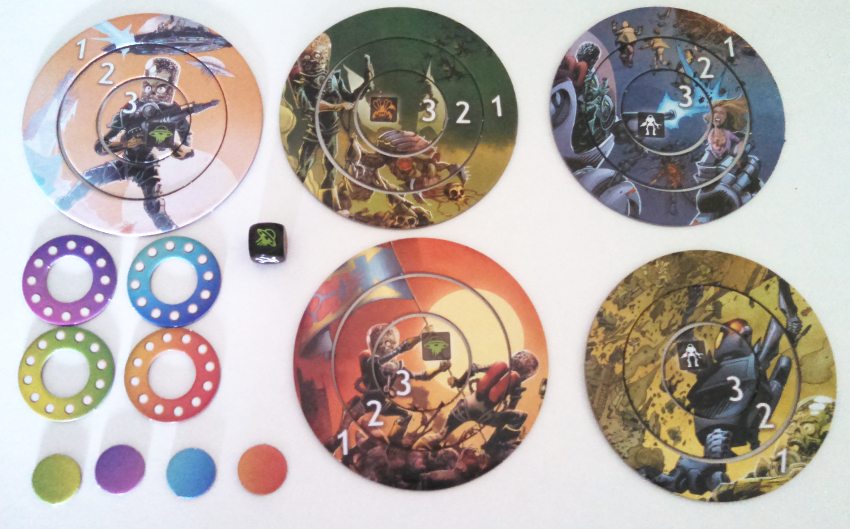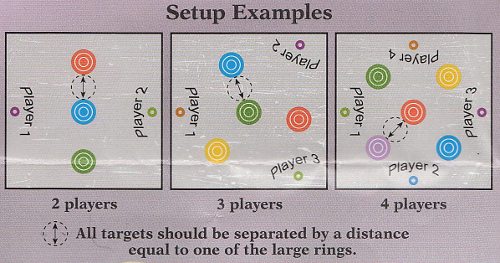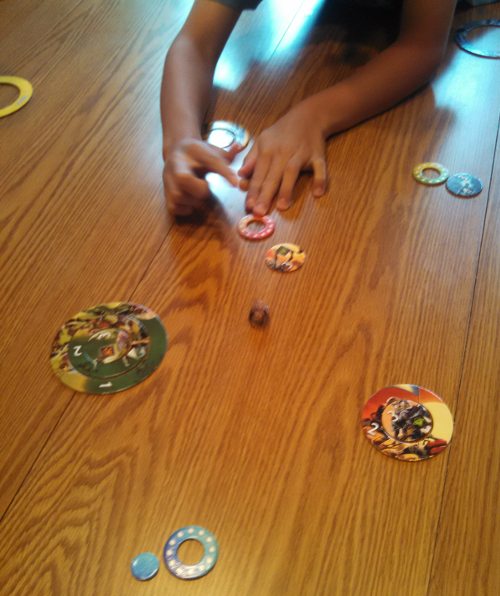Pluto’s gotten plenty of attention lately, but let’s talk Mars.
Specifically, Steve Jackson Games’ Mars Attacks: The Dice Game, and Mars Attacks: Ten-Minute Takedown. Both place players in the role of the Martian aggressors, and both license the colorful, cheesy-but-possibly-slightly-creepy Topps Mars Attacks artwork.
Both are also short, easy to learn, and the kind of thing I like to see in a casual game night mix. They’re the kind of light-strategy games that move quickly and are still conducive to holding conversations while being fun and entertaining.
Launched shortly after last year’s Gen Con, Mars Attacks: The Dice Game is in the vein of other Steve Jackson push-your-luck/stop-when-it’s-smart dice games. It’s designed for 3-6 players, ages 10 and up.
Getting set up: Everyone chooses a color, and takes the four tokens of that color. Designate a player to go first, and give them the first player marker. (It will never change hands–it’s just important to remember who went first when the final round is upon you.) Next, you’ll place the two-sided Difficulty Card on the table: two black-and-yellow “nuke” symbols showing for standard play, or flip it over so that only one is showing for a more difficult game. Shuffle the rest of the cards and deal a row of four face-down stacks, with the number of cards in each stack matching the number of players in the game. The rest of the cards stay out of play, but should remain unrevealed. Turn over the top card on each stack, and then line them up with the difficulty card so you’ve got a row of five, lining up all the nuke symbols, like this:
And you’re good to go!
You’re in the role of the Martians attacking earth. You’ll be targeting cities and monuments, trying to roll matching symbols and accumulating victory points, while trying to avoid getting nuked for your trouble.
Each player’s turn unfolds like this:
Check to see whether there are special rules affecting your turn–these will be printed in red or green boxes on city or landmark cards, and can range from ongoing bonuses that players get for claiming cards to specific conditions for earning a card.
Declare a target: Pick a city or landmark from the four face-up cards atop the stacks that you’re going to pursue, and let everyone know. Even if someone else has a token on a card, you can still go after it. If there’s a card with one of your tokens on it from a previous turn, you may target it again, picking up where you left off–but you don’t have to.
Roll all ten dice. First thing you do is check the nuke symbols you’ve rolled, and place those dice directly on the nuke symbols of the cards in play–one die per symbol. If you cover them all up (including the ones on the difficulty card), you’ve been nuked, and your turn ends without using any other die results.
The number of nukes you can sustain before being “nuked” on a turn will likely fluctuate throughout the game, since the city cards vary in how many nuke symbols appear on them. (Of the 29 city and monument cards, Detroit, Denver, Las Vegas, Memphis, and Seattle bear no nuke symbols, which means it’s possible that you’d find yourself in a situation where just one or two nukes on the dice, depending on which level of difficulty you’ve chosen, would end your turn.)
Not nuked? Check your progress: If you’ve targeted a city–with the exception of Los Angeles, which we’ll get to in a minute–then you’re looking to accumulate ray gun symbols. Take the ray guns you rolled and count them up. If you rolled enough to reach the total required to claim that city, you must claim that card. Follow any special rules on it, then place it face-up in front of you. Everyone should be able to see everyone else’s accumulated victory points and any special rules they’re using. You can claim just one card per turn. If you didn’t roll enough ray guns to claim the target card, you have a choice: you may continue the attack by re-rolling all of your Martian symbols, or you may stop and end your turn. Getting nuked rules still apply, though, so if you re-roll your Martians and get nuked, you’ll lose out on the ray guns you rolled so far; you don’t advance or place your player token on a targeted card until you’ve decided to end your turn.
If you’ve targeted a monument, you’ll notice that you’re trying to accumulate Martians, which means you’re committing to a one-roll turn. You have to apply any Martians rolled toward destroying that monument, so you can’t re-roll them. Being more difficult to claim, then, monuments are worth significantly more victory points.
The cities of Los Angeles and Las Vegas are played differently; Las Vegas can’t be targeted, but if it’s in play and you’re nuked, you place one of your tokens on the first numbered space or move to the next space if you’ve already got a token on the card. First player to get nuked three times while Vegas is in play claims the card. Los Angeles can be targeted like any other city, but the difference here is that you’re trying to roll nukes to claim it, even while the normal rules for getting nuked apply. So, say you’ve got six nuke spaces on the cards to fill, and you roll four nukes: you place them on the cards as usual. If you opt to end your turn, those four nukes count toward your progress in claiming L.A. If you’ve got Martians to re-roll, you’ve got to think carefully, because you can only add one more nuke to your progress–two more would wipe out your efforts for that turn.
In any case, after you re-roll, if you haven’t been nuked but still haven’t met the requirements to claim your target card, you can keep re-rolling as long as you’ve got Martians to do it.
When you decide to stop, you either place one of your tokens on the targeted card, covering the numbered space equal to the number of required symbols you rolled that turn, or you add your new results to the number indicated by a previously-placed token and move to the new total.
At the end of a turn, play passes to the left.
When someone claims the last card from one of the stacks, play continues until the person to the right of the first player has finished their turn, so that everyone will have had the same number of turns. Everyone adds up their victory points, and the highest total wins. Tie goes to the player who claimed the most cards, and then to the tied player who’s latest in the turn order.
While the press-your-luck mechanic at the core of Mars Attacks: The Dice Game is a familiar one, the variables introduced by the different values of target cards and the abundance of cards including special rules mean there’s plenty of opportunity to add some strategy and calculated risk-taking to the built-in randomness of a die-rolling game.
Mars Attacks: Ten-Minute Takedown, released this spring, is designed for 2-4 players.
The game comes with five three-piece targets composed of concentric rings, four flying saucer token rings, and a die with an alien monster, a robot, and a spacecraft on its faces. Like The Dice Game, it’s themed with Mars Attacks‘ vibrant, B-movie-style art.
Setup is arranged depending on the number of players, as shown here:
You begin your turn by placing the die in the center space of your flying saucer, then flicking the die toward any target you want. The die has to completely clear your flying saucer–if it doesn’t, shoot again.
If your shot doesn’t landed on a target, you take your flying saucer and place it over the die, establishing the origin point for your next shot, and it’s the next player’s turn. (If your flying saucer happens to overlap a target or another player’s saucer, you just scoot it back in the direction of your shot until the pieces are edge-to-edge.)
If your shot is true, and the die lands with any part of it touching the top surface of a target, you remove and keep the outermost ring of that target, scoring the number of points printed on it. It doesn’t matter where the die lands on the target–you only get the points on the outermost ring, even if you landed dead center. If the die happens to land showing an icon matching the one on that target, you remove the ring and flip it over for scoring, which adds a bonus point. (Also important: don’t absentmindedly fiddle with your pile of scored rings–you’ll need to remember which ones you flipped over to count for bonus points.) After claiming the ring for your score pile, you move your saucer back to base, and pass the die to the next player to your left.
It’s also possible your shot could end up on another player’s flying saucer, in which case their saucer gets sent back to its base. (If the die is bridging two pieces, like a saucer sitting adjacent to a target, you get both the points and the benefit of sending the other player’s saucer home.)
Die goes off the table? Your turn’s over. Die goes under the refrigerator? Everyone’s turn is over–at least until someone fishes it out with a yardstick or something.
It’s pretty straightforward: shoot the die, move your saucer, get points or send someone back to base. Pass the die and repeat. When all the targets have been claimed, the winner is the one with the most points. Ties go to the player with the most pieces, then to the player with the most center pieces.
Because your shooting position is constantly changing, Ten-Minute Takedown isn’t much of a sitting game; everyone winds up moving around the table to get their best angles, kind of like when you’re playing pool.
The game is rated for 10 and up, but my eight-year-old nephew joined his 10-year-old brother, his dad, and me, and the four of us had a pretty fun and competitive game–and only one off-the-table shot, which was a pleasant surprise. The increasing target values helped keep everyone in striking distance, score-wise.
In addition to gauging accuracy and distance, my brother and I discovered that, from very close range, it seems possible to increase your odds at getting the bonus by placing the die in a way that makes it more likely to match the icon on the target. (Your saucer location determines your die placement, but the rules don’t say anything about die facing: I suppose you could house-rule that the die facing at the end of one player’s shot should be maintained to begin the next player’s turn, which would mean you can’t choose a die facing to favor matching your target. Truthfully, the close-range success rate when choosing a facing was probably only slightly more than 50 percent anyway. It is also entirely possible that I put too much thought into this.)
We kept the color-matched pieces punched from the center of our saucers to use as reminders of where everyone’s original base was, which was useful once we were up and moving around the table, and when some of the targets started shifting through contact with the die.
Mars Attacks: Ten-Minute Takedown has a suggested retail price of $9.95; Mars Attacks: The Dice Game‘s suggested retail price is $19.95. GeekDad received one copy of each game for review purposes.


